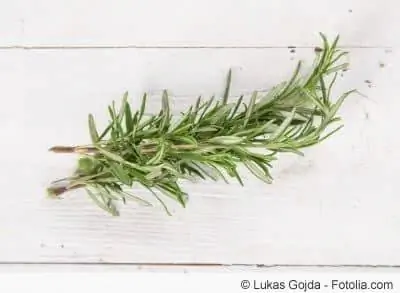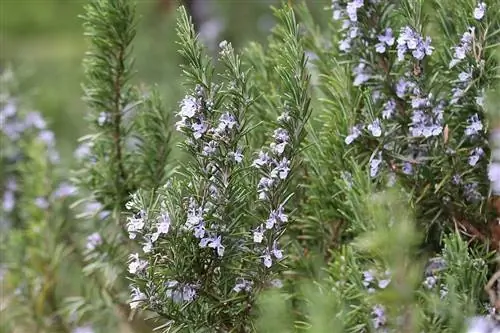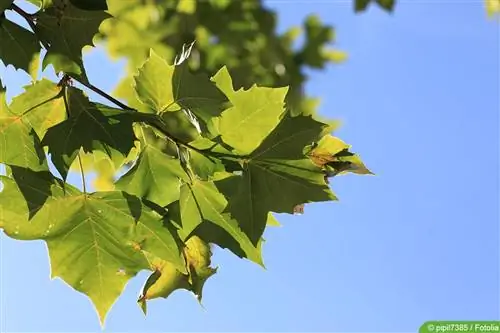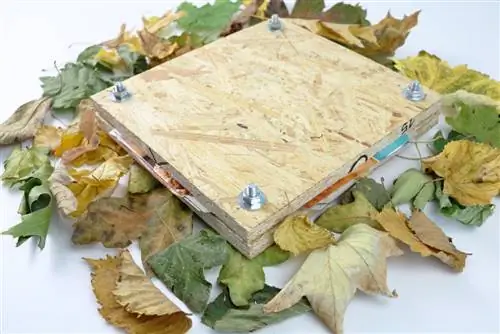- Author admin [email protected].
- Public 2023-12-17 03:39.
- Last modified 2025-01-24 12:45.
As a classic spice, medicinal and ornamental plant, rosemary thrives as a subshrub. This characteristic implies that the plant becomes woody in the lower regions, while the herbaceous shoot tips provide the longed-for herbal harvest and produce a magnificent flower. In the professional care protocol, pruning represents a horticultural challenge. Choosing the right time is just as important as the pruning itself. In addition, the clippings need to be stored properly to ensure the best quality. Read here how to cut rosemary and dry it properly.
The right time
There are various occasions on which the hobby gardener reaches for scissors to cut his rosemary bush. The initial focus is on harvesting the aromatic leaves in order to supply them to the kitchen. In addition, the subshrub requires annual maintenance pruning so that it does not become bare from the inside. Last but not least, the Mediterranean herb plant takes the shape of a decorative standard tree with the help of a targeted cutting technique. In practice, the following dates have proven to be advantageous:
- Harvest cutting for fresh consumption or for drying: From the end of April in the midday hours when the dew has dried
- Topiary: In connection with every harvest
- Maintenance cut: In late fall or early spring
- Rejuvenation cut: Preferably at the beginning of budding
- Training cut: Over the course of the entire growing season
Another motive for pruning is the rejuvenation of a neglected rosemary bush in order to breathe new life into it. If a shape and maintenance cut has been missed for several years, the months of January and February are considered the best time for a rejuvenation cut.
Tip:
If it has rained heavily in the previous days, the cutting date should be postponed. Both the aroma and the suitability for drying of rosemary are significantly affected by moisture.
Harvest cutting
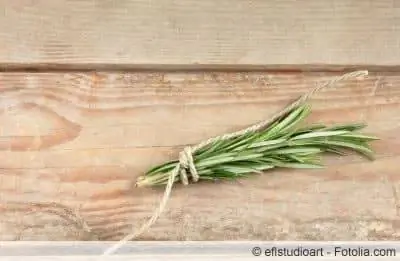
Not only the evergreen, needle-like leaves promise aromatic enjoyment, but also the sky-blue flowers. If you keep the habit as a subshrub in mind when harvesting rosemary, the process will be carried out professionally. Ideally, you not only cut off individual needle leaves, but also cut off entire branches just above the woody area. Please note that rosemary does not sprout again from old wood or only grows with great difficulty. Therefore, leave 0.5 to 1 cm of the herbaceous shoot part on the branch, as new branches with fresh leaves and new flowers will sprout from it. The flowers themselves are not cut, but picked.
Tip:
For cutting rosemary, only freshly sharpened cutting tools that have been meticulously disinfected with alcohol are used.
Topiary
Since a rosemary bush decorates the balcony and garden at the same time, prudent hobby gardeners combine every harvest with a topiary. How to do it right:
- As part of the harvest, take a few steps back repeatedly to decide what to do next
- Keep the natural growth habit in a round, oval or columnar silhouette if possible
- Cut off shoots that have outgrown the mold
The additional effort of a topiary in connection with the harvest is rewarded with dense, bushy growth and low woodiness. If the herbaceous shoot tips stay on the Mediterranean subshrub for too long, they become woody within a short time and drop the leaves. With regular pruning throughout the year, you can keep this tendency of the herb plant under control and enjoy the historic spice, medicinal and fragrant plant for many years to come.
Conservation cut
With floral stubbornness, a rosemary bush strives to become woody as quickly as possible. Since this tendency is at the expense of evergreen leaves and flowers, hobby gardeners are just as vehemently against it. In addition to harvest and shape pruning during the year, annual maintenance pruning also contributes to this. Here's how to do it:
- Short specimens that have overwintered outdoors by at least a third in spring
- Cut off all frozen shoot tips all around
- Cut off all dead wood at the base and thin it out thoroughly in this way
In the end, the plant should thrive again in an airy and loose manner, with the sun reaching the deepest regions. If a rosemary moves to a bright, frost-free winter quarters in the fall, the maintenance pruning can be carried out beforehand. This makes particular sense if the room is already crowded with other winter guests.
Rejuvenation cut
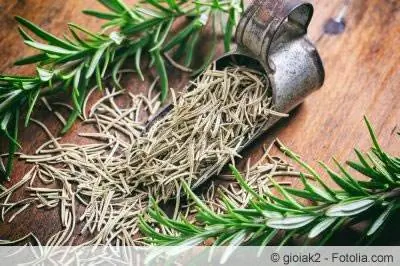
It quickly happens that a rosemary bush falls out of sight of regular garden care. In particular, winter-hardy varieties that thrive in beds are sometimes forgotten and are not consistently cut back. The result is an senile bush that, in the best case scenario, still thrives with leaves or a few flowers at the very tips. However, it would be premature to clear the plant because there is hope for it to grow again. Once winter has passed with its ground frosts and new growth is imminent, get the bare bush back on its feet. To do this, cut all branches down to 10 cm above the ground and fertilize generously with compost and horn shavings. In the period that follows, gardening patience is put to the test, because the plant can take its time until next year if it grows again.
Educational Cut
Conjure up a decorative standard tree from a rosemary bush that will decorate the balcony and garden with its evergreen foliage and perennial, wonderfully fragrant flowers. The plan is so uncomplicated:
- Select the strongest branch for the trunk of a two-year-old plant
- Cut off all side shoots coming from it
- Apply the scissors as close as possible to the trunk so that no coat hooks are created
While the main shoot is growing to the desired height, consistently cut off every new side and base shoot. Only then do you cut off the tip, whereupon lush branching begins. Determine 3 to 4 leading branches, which in turn are encouraged to branch out by making a cut. In this way you will train the subshrub into a magnificent standard tree over the years.
Drying
Although rosemary is suitable for preparing numerous cold and warm dishes, a lovingly cared for shrub regularly produces surplus clippings - far too good to be disposed of in the compost heap. It's a good thing that the southern aroma artist can be dried so well for a long shelf life. There are several procedures to choose from, which we explain in more detail below:
Air drying

Dry air is a free preservative, without any chemical additives. Although it takes some time for the herb branches to dry, hobby gardeners have favored this variant for generations. Tie the cut shoots together into small bouquets with raffia ribbon and hang them upside down in an airy, not too bright place. Check the binding material every now and then as it becomes loose as moisture escapes from the branches. The process is completed after 2 to 3 weeks. Now strip off the aromatic needles and store them in the dark screw-top jar until you are ready to use them.
Tip:
Do not hang rosemary bouquets in the kitchen to dry. The different food scents distort the typical herbal aroma over time. The attic or a basement room are more suitable.
In the oven
If air drying takes too long, convert the oven into a drying device for herbs. It's that easy:
- Rush the rosemary sprigs under cold water and pat dry with a paper towel
- Line a baking tray with baking paper to spread the shoots on it
- Preheat the oven to 40-50 degrees in circulating air mode
- Place the baking tray in the middle and leave it there for 2 to 3 hours
- Do not close the oven door completely, but use a wooden spoon or cork to hold it in place
Check the herb branches repeatedly during the process. Once properly dried, they can no longer be bent. Strip the needles from the cooled branches and store them in a light and airtight container.
In the dehydrator
In the private kitchen garden, when the harvest volume is higher, it is worth purchasing a dehydrator for preserving fruit and vegetables. A dehydrator is also suitable for drying rosemary. Spread the washed and dried branches loosely on the sieve floors so that a maximum of 90 percent of the area is covered. Then set the dehydrator to 45 to 50 degrees Celsius. The integrated heating with fan removes the moisture from the herbs within a few hours. If the branches have a brittle consistency, the dehydrator has done its job. As with all other procedures, only now pluck or strip off the needle leaves and put them in a dry, opaque container.
Conclusion
A regular cut is one of the mainstays of professional rosemary care. Don't just cut the evergreen shoots for harvesting, but also give the Mediterranean herb plant a neat shape at the same time. In addition, thin out the plant thoroughly in spring and cut back all branches by at least a third. If you are confronted with a neglected, senile herb bush, a bold rejuvenation cut down to 10 cm will work wonders. As part of the various pruning measures, a supply of rich branches is created that can be dried using simple means. Air-dry rosemary as a bouquet, spread out on the baking tray in the oven or conveniently in the dehydrator for a long shelf life.

